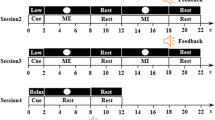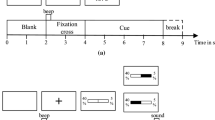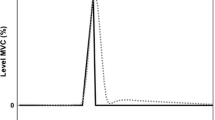Abstract
Time–domain feature representation for imagined grip force movement-related cortical potentials (MRCP) of the right or left hand and the decoding of imagined grip force parameters based on electroencephalogram (EEG) activity recorded during a single trial were here investigated. EEG signals were acquired from eleven healthy subjects during four different imagined tasks performed with the right or left hand. Subjects were instructed to execute imagined grip movement at two different levels of force. Each task was executed 60 times in random order. The imagined grip force MRCP of the right or left hand was analyzed by superposition and averaging technology, a single-trial extraction method, analysis of variance (ANOVA), and multiple comparisons. Significantly different features were observed among different imagined grip force tasks. These differences were used to decode imagined grip force parameters using Fisher linear discrimination analysis based on kernel function (k-FLDA) and support vector machine (SVM). Under the proposed experimental paradigm, the study showed that MRCP may characterize the dynamic processing that takes place in the brain during the planning, execution, and precision of a given imagined grip force task. This means that features related to MRCP can be used to decode imagined grip force parameters based on EEG. ANOVA and multiple comparisons of time–domain features for MRCP showed that movement-monitoring potentials (MMP) and specific interval (0–150 ms) average potentials to be significantly different among 4 different imagined grip force tasks. The minimum peak negativity differed significantly between high and low amplitude grip force. Identification of the 4 different imagined grip force tasks based on MMP was performed using k-FLDA and SVM, and the average misclassification rates of 27 % ± 5 % and 24 % ± 4 % across 11 subjects were achieved respectively. The minimum misclassification rate was 15 %, and the average minimum misclassification rate across 11 subjects was 24 % ± 4.5 %. This investigation indicates that imagined grip force MRCP may encode imagined grip force parameters. Single-trial decoding of imagined grip force parameters based on MRCP may be feasible. The study may provide some additional and fine control instructions for brain–computer interfaces.




Similar content being viewed by others
References
Pfurtscheller G, Christa N (2001) Motor imagery and direct brain–computer communication. Proc IEEE 89:1123–1134
Wolpaw JR, Birbaumer N, McFarland DJ et al (2002) Brain–computer interfaces for communication and control. Clin Neurophysiol 113:767–791
Blankertz B, Tangermann M, Vidaurre C et al (2010) The Berlin brain-computer interface: non-medical uses of BCI technology. Front Neurosci 4:198
Gürkök H, Nijholt A (2012) Brain–computer interfaces for multimodal interaction: a survey and principles. Int J Hum Comput Interact 28:292–307
Wang YJ, Wang RP, Gao XR et al (2006) A practical VEP-based brain–computer interface. IEEE Trans Rehabil Eng 14:234–240
Middendorf M, McMillan G, Calhoun G et al (2000) Brain–computer interface based on the steady-state visual-evoked response. IEEE Trans Rehabil Eng 8:211–214
Mak JN, Arbel Y, Minett JW et al (2011) Optimizing the P300-based brain–computer interface: current status, limitations and future directions. J Neural Eng 8:025003
Guo J, Gao SK, Hong B (2010) An auditory brain–computer interface using active mental response. IEEE Trans Neural Syst Rehabil Eng 18:230–235
Yin EW, Zhou ZT, Jiang J et al (2013) A novel hybrid BCI speller based on the incorporation of SSVEP into the P300 paradigm. J Neural Eng 10:10026012
Decety J (1996) The neurophysiological basis of motor imagery. Behav Brain Res 77:45–52
Shibasaki H, Hallett M (2006) What is the Bereitschaftspotential? Clin Neurophysiol 117:2341–2356
Pfurtscheller G, Lopes da Silva FH (1999) Event-related EEG/MEG synchronization and desynchronization: basic principles. Clin Neurophysiol 110:1842–1857
Neuper C, Wörtz M, Pfurtscheller G (2006) ERD/ERS patterns reflecting sensorimotor activation and deactivation. Prog Brain Res 159:211–222
Ma YN, Ge JQ, Xu XJ et al (2009) Asymmetric neurocognitive representation of ethnic in-group/out-group faces. Chin Sci Bull 54:2076–2081
Zhang JX, Fang Z, Du YC et al (2012) Centro-parietal N200: an event-related potential component specific to Chinese visual word recognition. Chin Sci Bull 57:1516–1532
Pfurtscheller G, Neuper C, Flotzinger D et al (1997) EEG-based discrimination between imagination of right and left hand movement. Electroencephalogr Clin Neurophysiol 103:642–651
Neuper C, Schlögl A, Pfurtscheller G (1999) Enhancement of left-right sensorimotor EEG differences during feedback-regulated motor imagery. J Clin Neurophysiol 16:373–382
Schlögl A, Lee F, Bischof H et al (2005) Characterization of four class motor imagery EEG data for the BCI-competition 2005. J Neural Eng 2:L14–L22
Zhao QB, Zhang LQ, Cichocki A (2009) EEG-based asynchronous BCI control of a car in 3D virtual reality environments. Chin Sci Bull 54:78–87
Gu Y, Dremstrup K, Farina D (2009) Single-trial discrimination of type and speed of wrist movements from EEG recordings. Clin Neurophysiol 120:1596–1600
Gu Y, Farina D, Murguialday AR et al (2009) Offline identification of imagined speed of wrist movements in paralyzed ALS patients from single-trial EEG. Front Neurosci 3:62
Gu Y, do Nascimento OF, Lucas MF et al (2009) Identification of task parameters from movement-related cortical potentials. Med Biol Eng Comput 47:1257–1264
do Nascimento OF, Farina D (2008) Movement-related cortical potentials allow discrimination of rate of torque development in imaginary isometric plantar flexion. IEEE Trans Biomed Eng 55:2675–2678
Farina D, do Nascimento OF, Lucas MF et al (2007) Optimization of wavelets for classification of movement-related cortical potentials generated by variation of force-related parameters. J Neurosci Methods 162:357–363
Yuan H, Perdoni C, He B (2010) Relationship between speed and EEG activity during imagined and executed hand movements. J Neural Eng 7:26001
Romero DH, Lacourse MG, Lawrence KE et al (2000) Event-related potentials as a function of movement parameter variations during motor imagery and isometric action. Behav Brain Res 117:83–89
do Nascimento OF, Nielsen KD, Voigt M (2005) Relationship between plantar-flexor torque generation and the magnitude of the movement-related potentials. Exp Brain Res 160:154–165
Neuper C, Scherer R, Reiner M et al (2005) Imagery of motor actions: differential effects of kinesthetic and visual-motor mode of imagery in single-trial EEG. Brain Res Cogn Brain Res 25:668–677
Hall CR, Martin KA (1997) Measuring movement imagery abilities: a revision of the movement imagery questionnaire. J Ment Imagery 21:143–154
Roberts R, Callow N, Hardy L et al (2008) Movement imagery ability: development and assessment of a revised version of the vividness of movement imagery questionnaire. J Sport Exerc Psychol 30:200
Campos A, Pérez MJ (1988) Vividness of movement imagery questionnaire: relations with other measures of mental imagery. Percept Mot Skills 67:607–610
Malouin F, Richards CL, Jackson PL et al (2007) The kinesthetic and visual imagery questionnaire (KVIQ) for assessing motor imagery in persons with physical disabilities: a reliability and construct validity study. J Neurol Phys Ther 31:20–29
Naito E (1994) Controllability of motor imagery and transformation of visual imagery. Percept Mot Skills 78:479–487
Callow N, Hardy L (2004) The relationship between the use of kinesthetic imagery and different visual imagery perspectives. J Sport Sci 22:167–177
Hwang HJ, Kwon K, Im CH (2009) Neurofeedback-based motor imagery training for brain-computer interface (BCI). J Neurosci Methods 179:150–156
Li JH, Zhang LQ (2010) Bilateral adaptation and neurofeedback for brain computer interface system. J Neurosci Methods 193:373–379
Miller KJ, Schalk G, Fetz EE et al (2010) Cortical activity during motor execution, motor imagery, and imagery-based online feedback. Proc Natl Acad Sci USA 107:4430–4435
Klem GH, Lüders HO, Jasper HH et al (1999) The ten-twenty electrode system of the International Federation of Clinical Neurophysiology. Electroencephalogr Clin Neurophysiol Suppl 52:3–6
Yang SY (2011) Pattern recognition and intelligent computing: Matlab technology realization. Publishing House of Electronics Industry, Beijing (in Chinese)
Yang XD, He AJ, Zhou Y et al (2010) Multifractal mass exponent spectrum of complex physiological time series. Chin Sci Bull 55:1996–2003
Slobounov SM, Ray WJ (1998) Movement-related potentials with reference to isometric force output in discrete and repetitive tasks. Exp Brain Res 123:461–473
Shibasaki H, Barrett G, Halliday E et al (1981) Cortical potentials associated with voluntary foot movement in man. Electroencephalogr Clin Neurophysiol 52:507–516
Cunnington R, Iansek R, Bradshaw JL et al (1996) Movement-related potentials associated with movement preparation and motor imagery. Exp Brain Res 111:429–436
do Nascimento OF, Nielsen KD, Voigt M (2006) Movement related parameters modulate cortical activity during imaginary isometric plantar-flexions. Exp Brain Res 171:78–90
Acknowledgments
The authors express their great thanks to the National Natural Science Foundation of China (60705021) and the research project of State Key Laboratory of Robotics of Shenyang Institute of Automation (SIA), Chinese Academy of Science (CAS) (08A120C101), Research project for application foundation of Yunnan Province (2013FB02b), Cultivation Program of Talents of Yunnan Province (KKSY201303048), and Focal Program for Education Office of Yunnan Province (2013Z130).
Author information
Authors and Affiliations
Corresponding author
About this article
Cite this article
Fu, Y., Xu, B., Li, Y. et al. Single-trial decoding of imagined grip force parameters involving the right or left hand based on movement-related cortical potentials. Chin. Sci. Bull. 59, 1907–1916 (2014). https://doi.org/10.1007/s11434-014-0234-5
Received:
Accepted:
Published:
Issue Date:
DOI: https://doi.org/10.1007/s11434-014-0234-5




